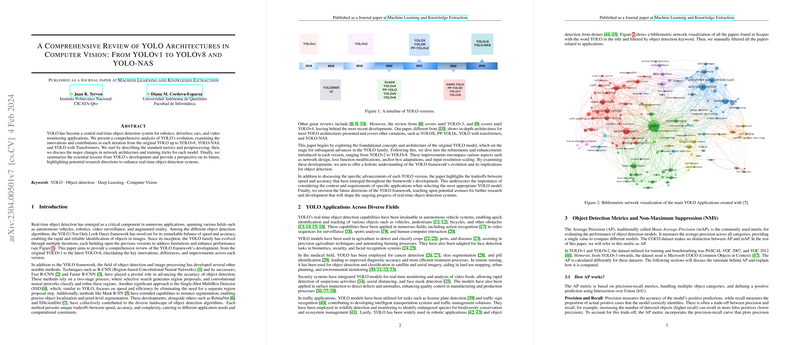Overview of YOLO Architectures in Computer Vision
This essay provides a comprehensive overview of the "YOLO Architectures in Computer Vision" paper, focusing on the evolution from YOLOv1 to YOLOv8 and YOLO-NAS. The YOLO (You Only Look Once) framework has been pivotal in real-time object detection, securing its place in applications such as robotics, autonomous vehicles, and surveillance due to its balance between speed and accuracy.
Key Developments
- YOLOv1 to YOLOv3:
- YOLOv1 introduced a novel approach, leveraging a single convolutional network for object detection without relying on sliding windows or region proposals.
- YOLOv2 enhanced this by incorporating anchor boxes and dimension clustering to improve localization accuracy, achieving an AP of 78.6% on VOC2007.
- YOLOv3 expanded capabilities with multi-scale predictions and a larger backbone (Darknet-53), marking a significant improvement on the COCO benchmark.
- YOLOv4 to YOLOv6:
- YOLOv4 integrated "bag-of-freebies" and "bag-of-specials," optimizing training while incorporating architectural changes like CSPDarknet53 and PANet, achieving 43.5% on COCO.
- YOLOv5, developed by Ultralytics in PyTorch, offered multiple scaled versions, further refining speed-accuracy tradeoffs.
- Scaled-YOLOv4 introduced a scalable architecture for both cloud and embedded systems, achieving up to 56% AP on COCO.
- YOLOv7 to YOLOv8 and Beyond:
- YOLOv7 optimized the architecture using E-ELAN and bag-of-freebies, maintaining state-of-the-art performance with reduced parameters.
- YOLOv8 by Ultralytics included an anchor-free model and decoupled head, achieving an AP of 53.9% on COCO.
- YOLO-NAS incorporated neural architecture search and hybrid quantization, delivering models tailored for real-time edge-device applications.
Innovations in Techniques
The paper details several innovations through the evolution of YOLO:
- Transition from anchor-based to anchor-free models, optimizing both simplicity and speed while maintaining accuracy.
- Incorporation of neural architecture search (NAS) in YOLO-NAS for automated architecture design.
- Introduction of advanced label assignment techniques and decoupled heads in YOLOX and YOLOv8, addressing classification and regression task alignment.
Applications and Implications
The YOLO architectures have been instrumental across multiple domains:
- Autonomous Vehicles: Facilitating rapid object recognition and decision-making.
- Surveillance and Security: Enabling real-time monitoring with high accuracy.
- Medical Imaging and Agriculture: Providing tools for enhanced diagnostics and precision farming.
With ongoing advancements, YOLO models are poised to enhance adaptability to hardware constraints, expand into multi-modal frameworks, and continue improving performance metrics.
Conclusion
The paper on YOLO's progression illustrates a robust trajectory of development that aligns with contemporary demands for real-time, efficient object detection solutions. The integration of cutting-edge architectures, innovative training methodologies, and broad adaptability underscores YOLO's relevance and potential in future computer vision technologies. As the framework evolves, its applications will likely broaden, encapsulating more complex tasks across diverse fields.
